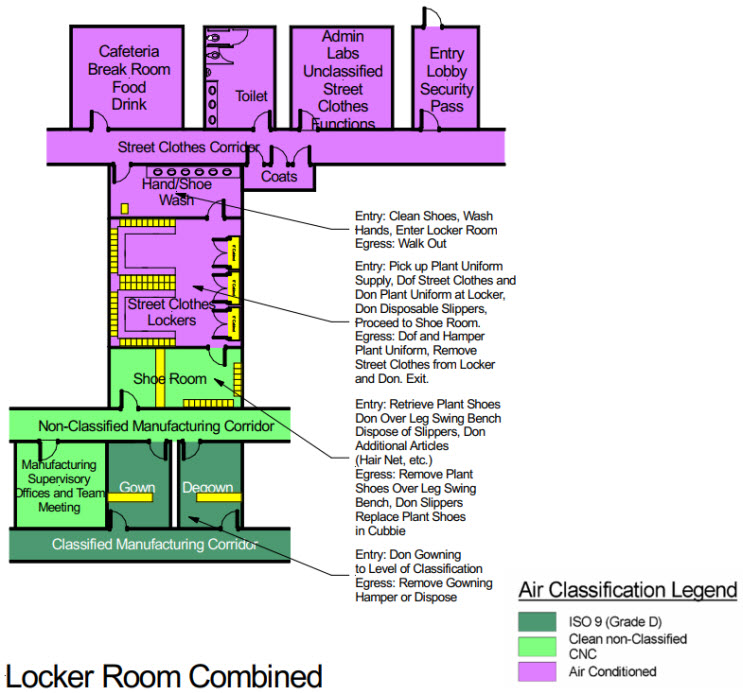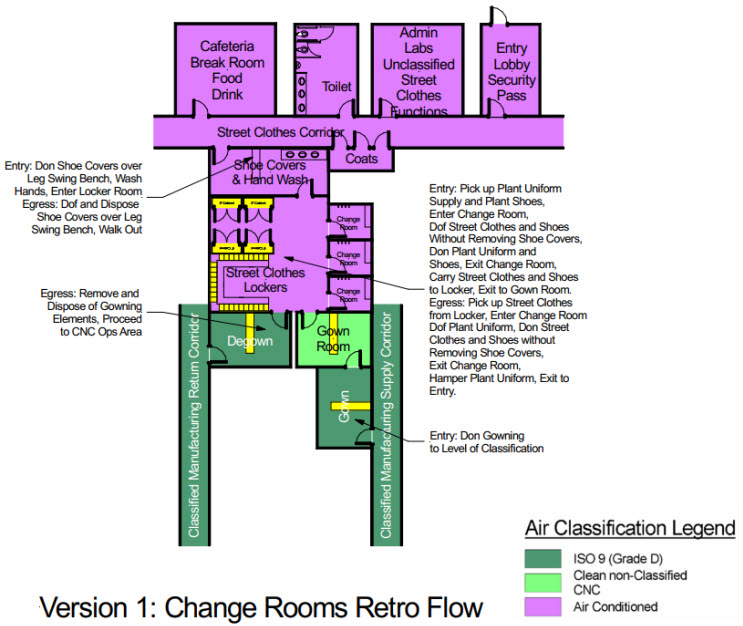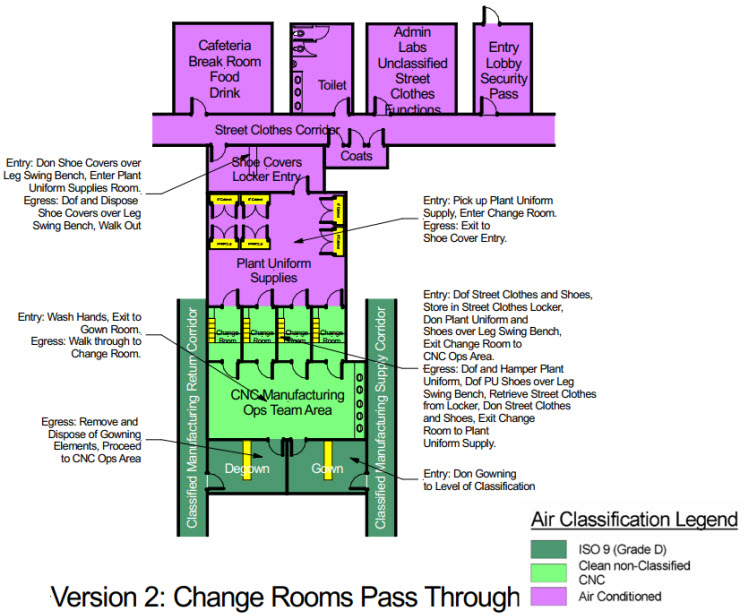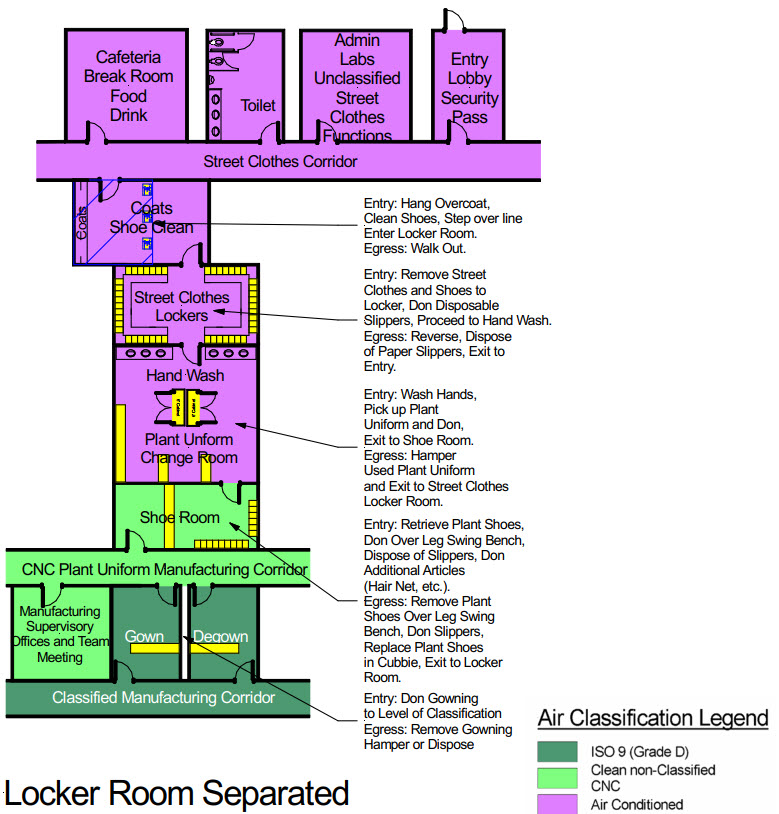GMP Plant Uniform Lockers And Procedures: Best Practices
By Geoff Middleton, architect, cGMA, Inc.

The advent and penetration of the plant uniform as the replacement for street clothes beneath articles of gowning within GMP manufacturing areas over the last decades is now nearly universal. Its adoption was driven by facilities experiencing contaminations and the persistent presence of adventitious organisms identified as originating from exterior environments within GMP zones. As the use of plant uniforms has gained acceptance, various procedures — and hence locker room layouts — have arisen across companies and sites. This article compares several alternatives observed in licensed operating facilities, seeks to examine and find optimized approaches to both procedures and layouts for plant uniform locker rooms, and proposes an optimized order of procedure and configuration, incorporating the same set of steps to produce a higher level of decontamination and cleanliness of incoming manufacturing and supporting staff.
Baseline Assumptions
As a baseline for this discussion, it is assumed for all versions that:
- Plant uniform elements are individually wrapped and protected from the external environment following laundering and up to the point of use.
- Plant uniforms in use are captive within the GMP manufacturing zone.
- Common circulation between plant uniformed and street clothed staff and visitors outside of the locker room is not permitted.
- Similarly, the GMP manufacturing zone is accessible only by plant uniformed staff. Street clothes are not allowed in GMP controlled areas. However, a lessor standard may exist for visitors on tour who will not enter manufacturing suites directly.
- Toileting, food consumption, smoking, etc., are not allowed while garbed in plant uniform.
For staff and visitors of a GMP manufacturing area, the plant uniform transition is the first in a set of transitions to access manufacturing spaces. While nomenclature varies between companies (scrubs, blues, etc.) and sites, the underlying meaning used here for “plant uniform” is company-controlled clothing that is worn within the GMP manufacturing environment in place of personal attire. Of note here is that the plant uniform is not gowning, per se, but instead consists of garments that replace personal street clothes. The physical makeup, condition, and cleanliness of plant uniforms are controlled by the company.
Note: The range of practices industrywide does not in all cases conform to these baseline precepts; however, they are both the basis for this discussion and a proposed summary of best practices.
The Plant Uniform
The plant uniform’s GMP purpose is not to have all staff and visitors look the same, though in many instances various colors or types of uniform are used to indicate functionality of staff members or to distinguish staff from visitors. Nor is it simply a benefit to employees to avoid wear and tear on their personal garb, though it may serve that purpose as well. Rather, it is to clear incoming staff of a significant proportion of external contaminants and materials upon entry, as well as to control the nature, condition, and hygiene of the garments themselves.
Street Clothes
In the case of personal garments worn by staff, we cannot be assured of the components of the fabrics or their condition that may generate excessive particulate material or provide sustenance for adventitious agents. We also cannot control the cleanliness of personal garments upon arrival. In any case, the preparation and commute to the manufacturing plant may involve a meal, toileting, and, certainly, interaction with the exterior environment that may expose the garments to dusts, molds, soils, chemical compounds, and organisms unwelcome in GMP environments. Street shoes, in particular, are notable vehicles for carryover of contaminants. It is generally accepted that exclusion of these external materials and influences from the GMP manufacturing environment is desirable and that removal of external articles of personal clothing upon entry is an effective means of accomplishing that goal.
Performance
As an analogy, a plant uniform locker room, or any transition space, acts similar to a filter. It has a performance level, just as a filter does. A high-performance filter (HEPA, for example) properly designed, mounted, and maintained may retain 99.97% of particulates within the target size ranges from the feed air. Other filter types may retain 85% or less. Though a filter media may be capable of achieving a rated level of effectiveness, if it is improperly mounted, designed, or maintained, it may not do so in practice. The next section discusses procedural and planning ramifications in plant uniform locker room design and usage that affect performance.
We know the start and ending conditions. At the start, one enters the locker room in personal street clothes. At the end, one enters the GMP manufacturing environment having removed one’s outer street clothes and donned elements of the company’s plant uniform. What happens in between, and how does it affect the outcome?
Procedure And Plan
At the outset, as a thought experiment, we can imagine a staff member or visitor arriving at the facility contaminated from head to toe. What we are imagining is dust, molds, pollen, soil, food particles, skin particles, adventitious agents, viruses, etc. In fact, all the materials and categories we wish to exclude from the GMP environment. In addition, street clothing may be in and of itself a source of particulates, depending on condition and materials of construction.
The common elements of any plant uniform transition procedure include hand washing, sometimes treatment of personal footwear, such as shoe cleaning or donning shoe covers, doffing street clothes and shoes, and depositing them in a personal locker, then donning elements of the plant uniform, including plant shoes. The challenge is sequencing and segregating activities in the locker room to remove or encapsulate the greatest proportion of contaminants. Observationally, typical suboptimal sequences tend to clean something and then recontaminate it from an unclean source. This includes, for example, washing the hands, then handling street shoes and clothing.
To facilitate discussion, several diagrammatic examples of plant uniform locker rooms and procedural sequences are included below. Each is based directly on a built, licensed facility in GMP operation.
Illustrated below is a typical sequence of activities and spaces in a plant uniform locker room. Note that this diagram depicts a single gender’s locker facility, of which two would typically be required.

Some notes:
- Initial hand washing is undermined by subsequent handling and removal of street clothes and shoes. In this instance, the now unclean hands are used to unwrap and don the plant uniform shirt and trousers, transferring soil to the freshly cleaned plant uniform.
- The newly unwrapped plant uniform is additionally handled and donned in close proximity to others who are at the same time doffing or donning their street clothing. Thus, the transfer of contaminants from adjacent activity to clean plant uniforms is likely.
- Doffing and donning clothing is a relatively strenuous physical activity that additionally exposes skin to the environment, making it a high producer of particulate materials. As plant uniform elements are exposed, they are inevitably contaminated.
- Segregation and dedication of plant shoes to the manufacturing zone floor is a good practice. At no point do plant shoes touch floor area shared with street shoes.
The advent of combined gender locker facilities with individual change rooms presents its own design requirements. Two recent alternatives from my observations are diagrammed below.


Notes:
- Doffing of street clothes and donning of the plant uniform in the same space with no opportunity to cleanse hands transfers contaminants from street clothing to fresh plant uniforms. This occurs in both of these alternatives. This is no different than the gender-specific locker room described above.
- In the first version, once the staff member has donned the plant uniform, they carry their street clothes upon egress from the changing room to their locker for storage. This transfer is likely to transfer contaminants to the fresh plant uniform. This condition does not occur in either the gender-specific locker room or the unidirectional alternative.
- Retro flow in the first version from the individual changing room back into the common locker area means staff wearing plant uniforms and street clothed staff interact, likely degrading the cleanliness of the fresh plant uniform. This is no different than the gender-specific locker room described above.
- Unidirectional passage of the individual changing rooms in the second version keeps plant uniformed and street clothed populations separated, which is a positive. However, the confined individual change room continues to transfer contaminants from street clothing to hands and to plant uniforms. (As a side note, the unidirectional nature of this version means an individual’s street clothes are placed in a locker within a specific changing room that must be remembered and returned to by the staff member upon egress.)
- Hand washing in the second version is now done following the donning of the plant uniform. This is more effective than hand washing before handling street clothes. Some quality leaders may question hand wash sinks with water in close proximity to the air classified manufacturing core.
A reconfigured plant uniform locker room is shown below. Combining the same steps and processes, it reorders the procedures and spaces to minimize recontaminations likely to occur in earlier diagrams, resulting in higher performance, i.e., less-contaminated staff entering the GMP manufacturing zone. Once again, this diagram represents one gender’s side of a two-sided locker facility.

Notes:
- Street shoe cleaning upon entry retains improved floor cleanliness in the street clothes locker room, thereby reducing carryover when proceeding to the plant uniform changing room.
- Hands are washed in a separate room following removal of street clothes and shoes, minimizing carryover to plant uniforms.
- Plant uniforms are handled and donned with clean hands.
- Plant uniformed staff now completely separated from any street clothing.
- Plant shoes are used only on a dedicated floor surface.
- Upon entry to the GMP manufacturing zone, high performance is achieved in exclusion of exterior contaminants.
Summary
While generally comprising the same procedural steps, each of the examples discussed and diagrammed varies significantly in performance when it comes to minimizing residual contaminants from external sources carried over into the GMP controlled manufacturing environment. The sequential and directional flow alternatives, whether gender common or segregated, provide a higher-performance outcome and a protective effect on GMP controlled manufacturing environments.
About The Author:
Geoff Middleton is an architect with cGMA, Inc. He has more than 30 years of experience designing cGMP, regulated products, pharmaceutical, and biologics manufacturing facilities of a wide breadth of sizes and types, all over the world.
